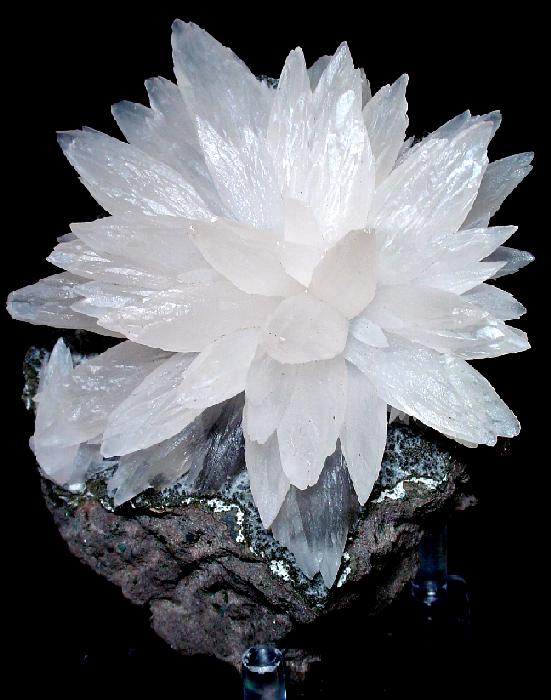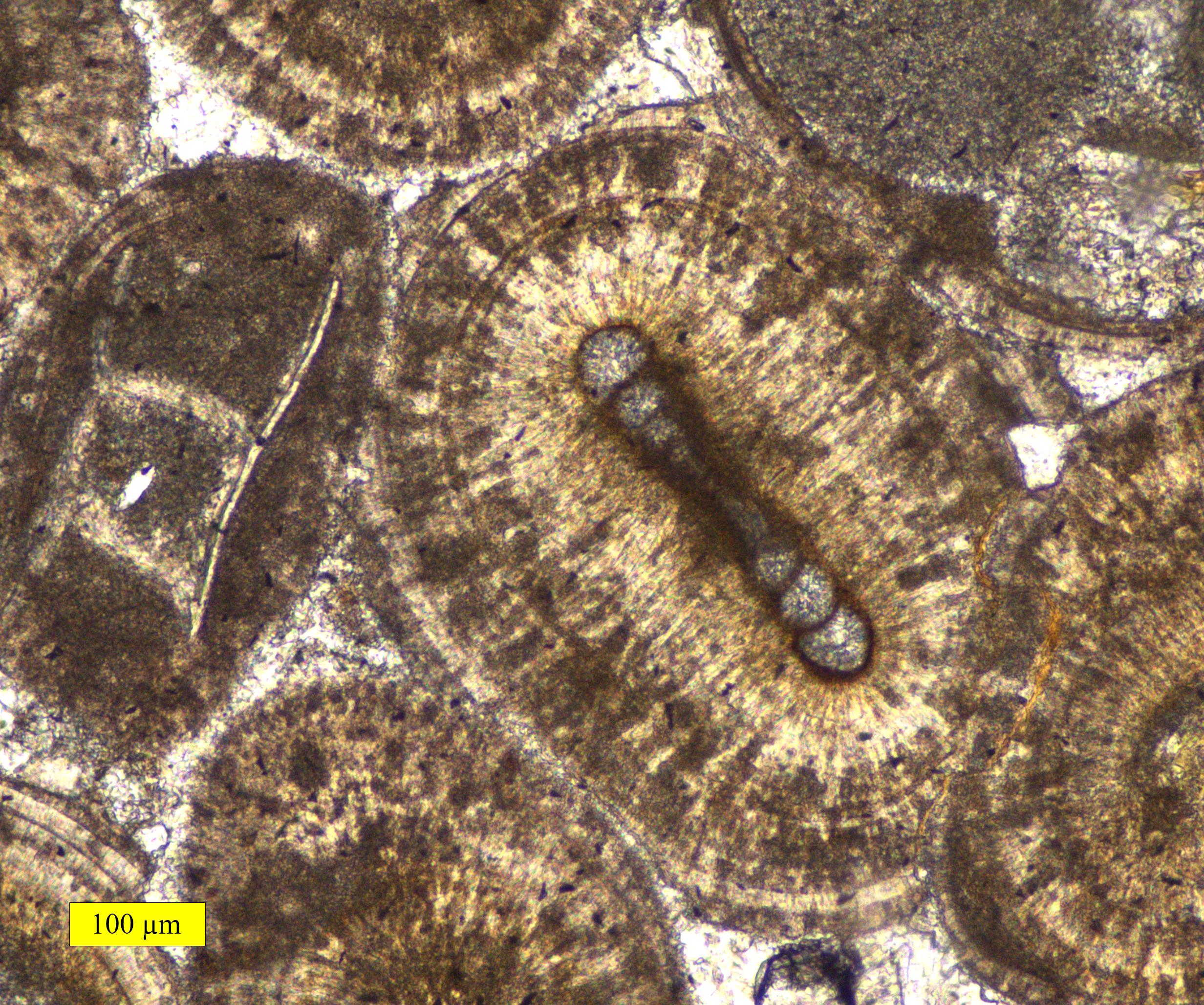|
Calcilutite
Calcilutite (also known as cementstone) is a type of limestone that is composed of predominantly, more than 50 percent, of either clay-size or both silt-size and clay-size detrital (transported) carbonate grains. These grains consist either of fossil fragments, ooids, intraclasts, pellets, other grains, or some combination of them. The term calcilutite was originally proposed in 1903 by GrabauGrabau, A.W. (1903) ''Paleozoic coral reefs.'' Geological Society of America Bulletin. vol. 14, pp. 337-352.Grabau, A.W. (1904) ''On the classification of sedimentary rocks.'' American Geologist. vol. 33, pp. 228-247. as a part of his calcilutite, calcarenite and calcirudite classification system based upon the size of the detrital grains composing a limestone.Neuendorf, K.K.E., J.P. Mehl, Jr., and J.A. Jackson, J.A., eds. (2005) ''Glossary of Geology'' (5th ed.). Alexandria, Virginia, American Geological Institute. 779 pp. Flügel, E. (2010) ''Microfacies of Carbonate Rocks'', 2nd ed. Springe ... [...More Info...] [...Related Items...] OR: [Wikipedia] [Google] [Baidu] |
Calcisiltite
Calcisiltite is a type of limestone that is composed predominantly, more than 50 percent, of detrital (transported) silt-size carbonate grains. These grains consist either of the silt-size particles of ooids, fragments of fossil shells, fragments of older limestones and dolomites, intraclasts, pellets, other carbonate grains, or some combination of these. Calcisiltite is the carbonate equivalent of a siltstone.Neuendorf, K.K.E., J.P. Mehl, Jr., and J.A. Jackson, J.A., eds. (2005) ''Glossary of Geology'' (5th ed.). Alexandria, Virginia, American Geological Institute. 779 pp. Flügel, E. (2010) ''Microfacies of Carbonate Rocks'', 2nd ed. Springer-Verlag Berlin, Germany. 976 pp. Calcisiltites can accumulate in a wide variety of coastal, lacustrine, and marine environments. It is typically the product of abrasion and bioerosion.Scholle, P.A., D.G. Bebout, and C.H. Moore (1983) ''Carbonate Depositional Environments.'' Memoir no. 33. Tulsa, Oklahoma, American Association of Petroleum ... [...More Info...] [...Related Items...] OR: [Wikipedia] [Google] [Baidu] |
Calcarenite
Calcarenite is a type of limestone that is composed predominantly, more than 50 percent, of detrital (transported) sand-size (0.0625 to 2 mm in diameter), Carbonate rock, carbonate grains. The grains consist of sand-size grains of either corals, Seashell, shells, ooids, intraclasts, Pellets (petrology), pellets, fragments of older limestones and Dolomite (rock), dolomites, other carbonate grains, or some combination of these. Calcarenite is the carbonate equivalent of a sandstone. The term calcarenite was originally proposed in 1903 by Amadeus William Grabau, GrabauGrabau, A.W. (1903) ''Paleozoic coral reefs.'' Geological Society of America Bulletin. vol. 14, pp. 337-352.Grabau, A.W. (1904) ''On the classification of sedimentary rocks.'' American Geologist. vol. 33, pp. 228-247. as a part of his calcilutite, calcarenite and calcirudite carbonate classification system based upon the size of the detrital grains composing a limestone.Flügel, E. (2010) ''Microfacies of Carbonate ... [...More Info...] [...Related Items...] OR: [Wikipedia] [Google] [Baidu] |
Calcirudite
Calcirudite is a type of limestone that is composed predominantly, more than 50 percent, of carbonate grains that are larger in size than sand (2 mm in diameter). The grains can consist of either fragments of fossils, fragments of older limestones and dolomites, other carbonate grains, or some combination of these. The term calcirudite was originally proposed in 1903 by GrabauGrabau, A.W. (1903) ''Paleozoic coral reefs.'' Geological Society of America Bulletin. vol. 14, pp. 337-352.Grabau, A.W. (1904) ''On the classification of sedimentary rocks.'' American Geologist. vol. 33, pp. 228-247. as a part of his calcilutite, calcarenite and calcirudite classification system based upon the size of the detrital grains composing a limestone.Neuendorf, K.K.E., J.P. Mehl, Jr., and J.A. Jackson, J.A., eds. (2005) ''Glossary of Geology'' (5th ed.). Alexandria, Virginia, American Geological Institute. 779 pp. Flügel, E. (2010) ''Microfacies of Carbonate Rocks'', 2nd ed. Springer-Verlag Berl ... [...More Info...] [...Related Items...] OR: [Wikipedia] [Google] [Baidu] |
Limestone
Limestone is a type of carbonate rock, carbonate sedimentary rock which is the main source of the material Lime (material), lime. It is composed mostly of the minerals calcite and aragonite, which are different Polymorphism (materials science), crystal forms of calcium carbonate . Limestone forms when these minerals Precipitation (chemistry), precipitate out of water containing dissolved calcium. This can take place through both biological and nonbiological processes, though biological processes, such as the accumulation of corals and shells in the sea, have likely been more important for the last 540 million years. Limestone often contains fossils which provide scientists with information on ancient environments and on the evolution of life. About 20% to 25% of sedimentary rock is carbonate rock, and most of this is limestone. The remaining carbonate rock is mostly Dolomite (rock), dolomite, a closely related rock, which contains a high percentage of the mineral Dolomite (mine ... [...More Info...] [...Related Items...] OR: [Wikipedia] [Google] [Baidu] |
Carbonate Rock
Carbonate rocks are a class of sedimentary rocks composed primarily of carbonate minerals. The two major types are limestone, which is composed of calcite or aragonite (different crystal forms of CaCO3), and Dolomite (rock), dolomite rock (also known as dolostone), which is composed of Dolomite (mineral), dolomite (CaMg(CO3)2). They are usually Dunham classification, classified on the basis of texture and grain size. Importantly, carbonate rocks can exist as metamorphic and igneous rocks, too. When recrystallized carbonate rocks are Metamorphic rock, metamorphosed, marble is created. Rare igneous rock, igneous carbonate rocks even exist as Intrusive rock, intrusive carbonatites and, even rarer, there exists volcanic carbonate lava. Carbonate rocks are also crucial components to understanding Geological history of Earth, geologic history due to processes such as diagenesis in which carbonates undergo compositional changes based on kinetic effects. The correlation between this compo ... [...More Info...] [...Related Items...] OR: [Wikipedia] [Google] [Baidu] |
Fossil
A fossil (from Classical Latin , ) is any preserved remains, impression, or trace of any once-living thing from a past geological age. Examples include bones, shells, exoskeletons, stone imprints of animals or microbes, objects preserved in amber, hair, petrified wood and DNA remnants. The totality of fossils is known as the ''fossil record''. Though the fossil record is incomplete, numerous studies have demonstrated that there is enough information available to give a good understanding of the pattern of diversification of life on Earth. In addition, the record can predict and fill gaps such as the discovery of '' Tiktaalik'' in the arctic of Canada. Paleontology includes the study of fossils: their age, method of formation, and evolutionary significance. Specimens are sometimes considered to be fossils if they are over 10,000 years old. The oldest fossils are around 3.48 billion years to 4.1 billion years old. Early edition, published online before prin ... [...More Info...] [...Related Items...] OR: [Wikipedia] [Google] [Baidu] |
Ooid
Ooids (, ) are small (commonly ≤2 mm in diameter), spheroidal, "coated" (layered) sedimentary grains, usually composed of calcium carbonate, but sometimes made up of iron- or phosphate-based minerals. Ooids usually form on the sea floor, most commonly in shallow tropical seas (around the Bahamas, for example, or in the Persian Gulf). After being buried under additional sediment, these ooid grains can be cemented together to form a sedimentary rock called an '' oolite''. Oolites usually consist of calcium carbonate; these belong to the limestone rock family. Pisoids are similar to ooids, but are larger than 2 mm in diameter, often considerably larger, as with the pisoids in the hot springs at Carlsbad (Karlovy Vary) in the Czech Republic. Ooids have been the subject of scientific research for centuries.https://www.geological-digressions.com/the-mineralogy-of-carbonates-non-skeletal-grains/ Formation An ooid forms as a series of concentric layers around a nucleus. T ... [...More Info...] [...Related Items...] OR: [Wikipedia] [Google] [Baidu] |
Intraclasts
In geology, intraclasts are irregularly-shaped grains that form by syndepositional erosion (i.e. erosion simultaneous with deposition) of partially-lithified sediment. Gravel grade material is generally composed of whole disarticulated or broken skeletal fragments together with sand grade material of whole, disaggregated and broken skeletal debris. Such sediments can contain fragments of early cemented limestones of local origin which are known as intraclasts. Extraclasts are sediments that contain pieces of early cemented limestones of extra-basinal origin. Examples of intraclasts include mudlumps that are torn up from the bottoms of lagoons during storms, hardened desiccated mudflakes produced in intertidal and supratidal environments and fragments broken from cemented deep-sea crusts. Other intraclasts are aggregates of carbonate particles. These include grapestones and botryoidal grains. Grapestones are composite grains with an irregular shape that resembles a bunch of ... [...More Info...] [...Related Items...] OR: [Wikipedia] [Google] [Baidu] |
Pellets (petrology)
Pellets are small spherical to ovoid or rod-shaped grains that are common component of many limestones. They are typically 0.03 to 0.3 mm long and composed of carbonate mud (micrite). Their most common size is 0.04 to 0.08 mm. Pellets typically lack any internal structure and are remarkably uniform in size and shape in any single limestone sample. They consist either of aggregated carbonate mud, precipitated calcium carbonate, or a mixture of both. They either are or were composed either of aragonite, calcite, or a mixture of both. Also, pellets composed of either glauconite or phosphorite are common in marine sedimentary rocks. Pellets occur in Precambrian through Phanerozoic strata. They are an important component mainly in Phanerozoic strata. The consensus among sedimentologists and petrographers is that pellets are the fecal products of invertebrate organisms because of their constant size, shape, and extra-high content of organic matter.Folk, R.L. (1959) ''Practical ... [...More Info...] [...Related Items...] OR: [Wikipedia] [Google] [Baidu] |
Mudstone
Mudstone, a type of mudrock, is a fine-grained sedimentary rock whose original constituents were clays or muds. Mudstone is distinguished from ''shale'' by its lack of fissility.Blatt, H., and R.J. Tracy, 1996, ''Petrology.'' New York, New York, W. H. Freeman, 2nd ed, 529 pp. The term ''mudstone'' is also used to describe carbonate rocks (limestone or dolomite) that are composed predominantly of carbonate mud. However, in most contexts, the term refers to siliciclastic mudstone, composed mostly of silicate minerals. The NASA Curiosity rover has found deposits of mudstone on Mars that contain organic substances such as propane, benzene and toluene. Definition There is not a single definition of mudstone that has gained general acceptance,Boggs 2006, p.143 though there is wide agreement that mudstones are fine-grained sedimentary rocks, composed mostly of silicate grains with a grain size less than . Individual grains this size are too small to be distinguished without a micros ... [...More Info...] [...Related Items...] OR: [Wikipedia] [Google] [Baidu] |
Lake
A lake is often a naturally occurring, relatively large and fixed body of water on or near the Earth's surface. It is localized in a basin or interconnected basins surrounded by dry land. Lakes lie completely on land and are separate from the ocean, although they may be connected with the ocean by rivers. Lakes, as with other bodies of water, are part of the water cycle, the processes by which water moves around the Earth. Most lakes are fresh water and account for almost all the world's surface freshwater, but some are salt lakes with salinities even higher than that of seawater. Lakes vary significantly in surface area and volume of water. Lakes are typically larger and deeper than ponds, which are also water-filled basins on land, although there are no official definitions or scientific criteria distinguishing the two. Lakes are also distinct from lagoons, which are generally shallow tidal pools dammed by sandbars or other material at coastal regions of ocean ... [...More Info...] [...Related Items...] OR: [Wikipedia] [Google] [Baidu] |






